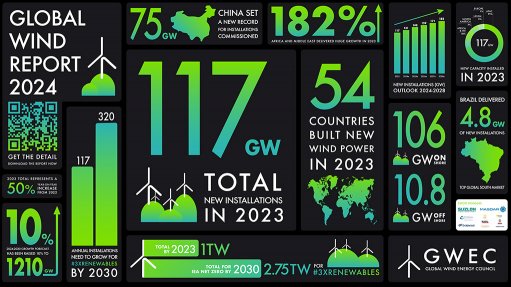Solar energy offers benefits for airports
Airports in Africa have the opportunity to implement solar energy projects that will have various benefits, ranging from environmental to financial, speakers said during an Africa Solar Industry Association- (AFSIA-) hosted webinar on July 7.
Barrett Energy principal Stephen Barrett said solar energy and airports were a good match owing to a number of elements. This includes airports already having existing on site load and electrical infrastructure.
Also, airports, may have underused land, which is ideal for ground-mounted solar installations.
Moreover, airports are generally economic hubs for the area, which make them suitable for the development of all types of projects, and solar is suited to this, as it can provide ancillary public benefits and is often a focus of government policy.
Barret identified three of the best solar configurations for airports − ground-mounted, canopy mounted and roof-mounted.
He indicated that ground-mounted solar presented the best option for land-rich airports, with it fitting well in an underused property. This is the most cost effective solution for airports when building large-scale projects, however, this is obviously dependent on the size of land available to the airport.
Canopy-mounted installations, or carports, are a more expensive option, because these require more materials, as the canopy has to be built as well. However, these provide a customer benefit in terms of shade for parking.
Lastly, roof-mounted installations are typically used for smaller projects, as they have to fit on the roof, and provide on-site electricity use. Barret indicated that these were well suited for government initiatives.
Barret emphasised that one of the factors to consider when pursuing solar projects at airports was the glare from the installation. While solar projects aim to reduce glare as much as possible to ensure that no energy is wasted, there is some glare owing to the materials used.
Therefore, this calls for a glare analysis, to ensure that the control tower and aircrafts’ final flights paths are not adversely affected. He said a tool had been developed in the US that models this out, therefore, those interested can use it to see if the location and project will work.
TECHNICAL CONSIDERATIONS
Meanwhile, Solarcentury project manager Peter Sweetnam provided more information on the technical considerations for each of the three installation types for airports, which would determine which option operators would pursue for their specific airport.
He noted that for roof-mounted projects, the top three things to consider are the condition of the roof; its shape and size; and the fact that it would most likely provide the cheapest option.
Sweetnam worked on a solar energy project at the Mombasa airport in Kenya. He indicated that on this project, the roof was old, with multiple issues, and was therefore not favourable for this type of installation.
For the ground-mounted installation, he noted that the top three things to consider are the available land, which will determine the size of the project; whether the land being pursued is earmarked for future expansion; and the fact that this type of installation allows for optimal tilt and orientation on the panels.
For the Mombasa project, some of the land that had been envisioned for the project was earmarked for a future hotel development, therefore, the design had to be shifted.
For carport installation, the top three things to consider are the higher cost; the added benefit of shade; and the fact that it is likely to be the most restrictive in system size, depending on the amount of free parking bays available for such an installation.
One successful airport solar project in Africa was mentioned by Cameroon Airports Company safety, security and environment director Mazarin Herve Mintsa,namely, a ground-mounted solar-at-gate project implemented at the Douala International Airport.
Minsta indicated that this project has provided a number of benefits for the airport, including reduction in carbon dioxide emissions; and cost savings in terms of the electricity bill.
Comments
Press Office
Announcements
What's On
Subscribe to improve your user experience...
Option 1 (equivalent of R125 a month):
Receive a weekly copy of Creamer Media's Engineering News & Mining Weekly magazine
(print copy for those in South Africa and e-magazine for those outside of South Africa)
Receive daily email newsletters
Access to full search results
Access archive of magazine back copies
Access to Projects in Progress
Access to ONE Research Report of your choice in PDF format
Option 2 (equivalent of R375 a month):
All benefits from Option 1
PLUS
Access to Creamer Media's Research Channel Africa for ALL Research Reports, in PDF format, on various industrial and mining sectors
including Electricity; Water; Energy Transition; Hydrogen; Roads, Rail and Ports; Coal; Gold; Platinum; Battery Metals; etc.
Already a subscriber?
Forgotten your password?
Receive weekly copy of Creamer Media's Engineering News & Mining Weekly magazine (print copy for those in South Africa and e-magazine for those outside of South Africa)
➕
Recieve daily email newsletters
➕
Access to full search results
➕
Access archive of magazine back copies
➕
Access to Projects in Progress
➕
Access to ONE Research Report of your choice in PDF format
RESEARCH CHANNEL AFRICA
R4500 (equivalent of R375 a month)
SUBSCRIBEAll benefits from Option 1
➕
Access to Creamer Media's Research Channel Africa for ALL Research Reports on various industrial and mining sectors, in PDF format, including on:
Electricity
➕
Water
➕
Energy Transition
➕
Hydrogen
➕
Roads, Rail and Ports
➕
Coal
➕
Gold
➕
Platinum
➕
Battery Metals
➕
etc.
Receive all benefits from Option 1 or Option 2 delivered to numerous people at your company
➕
Multiple User names and Passwords for simultaneous log-ins
➕
Intranet integration access to all in your organisation


















